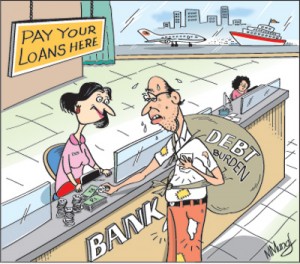Columns
How burdensome is the country’s increasing indebtedness?
View(s):The increasing debt — both domestic and foreign — is a serious economic concern. The current debt position exceeds acknowledged thresholds — the fiscal deficit of 5 per cent of GDP and the debt to GDP ratio of less than 60 per cent of GDP.
 However Dr. Mohamed Z. M. Aazim, Deputy Superintendent of Public Debt of the Central Bank, in response to my recent columns, says I do not appropriately acknowledge that the debt/GDP ratio has been constantly falling over the years, from 90.6 per cent in 2005 to 78.3 per cent in 2013. Furthermore, he says that when commenting on fiscal deficit of 5.9 per cent, that I have failed to see the continuous improvements since 2009 from 9.9 per cent in 2009 to 5.9 per cent in 2013.
However Dr. Mohamed Z. M. Aazim, Deputy Superintendent of Public Debt of the Central Bank, in response to my recent columns, says I do not appropriately acknowledge that the debt/GDP ratio has been constantly falling over the years, from 90.6 per cent in 2005 to 78.3 per cent in 2013. Furthermore, he says that when commenting on fiscal deficit of 5.9 per cent, that I have failed to see the continuous improvements since 2009 from 9.9 per cent in 2009 to 5.9 per cent in 2013.
Although the debt/GDP ratio and the fiscal deficit have been brought down, they are far too high and burdensome. This satisfaction with a reduction of these ratios both by the Central Bank and its Deputy Superintendent of Public Debt epitomises complacency about a serious economic problem.
Debt burden
The view that Sri Lanka’s debt burden has been declining is based on a single statistic of the debt to GDP ratio that has declined not due to a decrease in debt but owing to the GDP increasing. Even then, in 2011, this ratio increased and when it decreased it was slight and well below the Government’s own target.
The public debt has ballooned in recent years from Rs. 3,589 billion in 2008 to Rs 6,793 billion in 2013. This is a huge increase of about 90 per cent in just five years. The pertinent issue is not whether it has increased or decreased by a few percentage points as a ratio of GDP, but whether the debt to GDP ratio is at an acceptable level and whether its servicing costs are a burden or not.
 It is not simply the amount of the public debt per se that matters, but its composition between short term and long term debt, interest costs, the repayment schedule and overall maturity structure. For instance, there is deterioration in the debt situation even when the debt ratio remains the same or declines, if the maturity structure is skewed towards short term debt. Therefore the mere decline in the debt to GDP ratio is not an adequate indicator of indebtedness.
It is not simply the amount of the public debt per se that matters, but its composition between short term and long term debt, interest costs, the repayment schedule and overall maturity structure. For instance, there is deterioration in the debt situation even when the debt ratio remains the same or declines, if the maturity structure is skewed towards short term debt. Therefore the mere decline in the debt to GDP ratio is not an adequate indicator of indebtedness.
Debt to GDP threshold
A debt to GDP ratio of over 60 per cent is detrimental to the economy. It is for this reason that in December 2002 the Fiscal Management Responsibility Act (FMRA) was passed in parliament making it mandatory for the Government to take measures to ensure that the fiscal deficit is brought down to 5 percent of GDP in 2006 and kept at that level thereafter. As it turned out, the fiscal deficit was 8 per cent of GDP that year and averaged 8 per cent of GDP in the five years (2004-2008). The FMRA also required the public debt to be brought down to 60 per cent of GDP by 2013. However neither the fiscal deficit targets nor the debt to GDP goal was achieved and in 2004 the FMRA was discontinued owing to the Tsunami difficulties.
These objectives have not been achieved even in 2013 when the debt to GDP ratio was as high as 78.3 per cent and the fiscal deficit was 5.9 per cent, even without including debt incurred by state agencies from banks that are contingent liabilities of the Government.
Broader analysis
Debt is not necessarily bad for an economy. Foreign borrowing provides a means by which the savings-investment gap could be reduced. However when foreign borrowing exceeds an amount where its servicing costs (interest and capital repayments) through export earnings are too high, then it is on the road to a debt trap. This is particularly so if the borrowed funds are utilised in a manner that does not increase the country’s export earnings.
Economists’ views
Dr. Aazim may recall that at the last annual sessions of the Sri Lanka Economic Association, where he was present and read a paper, there was a consensus that the fiscal deficit should not exceed 5 per cent and that the level of the debt was too high and that it was not the amount of the debt alone that is of consequence, but the high interest rates, conditions of borrowing and the uses of debt that are not resulting in export earnings to make the debt burden less onerous. I don’t think Dr. Aazim disagreed with any of these positions. Being a trained economist he would himself agree, though his response “that does not necessarily reflect the views of the institution he works in,” reflects the Central Bank’s persistent complacency.
Debt burden
The debt servicing cost as a proportion of revenue is a better indicator of the crippling effect of the large public debt. In 2009 and 2010 debt servicing cost was 118 per cent and 104 per cent of revenue and in 2013 too debt servicing costs absorbed more than the total revenue (102 per cent). The inadequacy of revenue to meet debt servicing costs means that all current and capital expenditure have to be met by further borrowing from domestic and foreign sources. The high debt servicing costs have distorted priorities in public expenditure allocations and funding for education and health have been inadequate.
Dr. Aazim takes issue with my assertion that the inability of revenue to even meet debt servicing costs is alarming. If debt servicing costs absorbing the entirety of government revenue is not alarming, then what is? Just imagine the plight of a household whose total income has to be spent on debt repayments and has to borrow for even its consumption needs.
Fiscal policy
Fiscal policy is the responsibility of the Government and not that of the Central Bank. However, it has not been forceful enough as a watch dog of the economy and as the Economic Advisor to the Government to drive home to the Government that it was imperative to improve its fiscal management. Defending the weak public finances and the fiscal management of the Government by Central Bank economists are not in the interest of the economy. Hopefully, this analysis would provide other economists in the Central Bank “with an expanded horizon and…… a more unbiased comprehensive picture of the state of the Sri Lankan economy.”
(This is a response to Dr. Aazim’s critique in the Business Times of May 11th on my May 4th column. The other issues raised by him on FDI and foreign borrowing are discussed in today’s Business Times. Please visit Business Times article.

